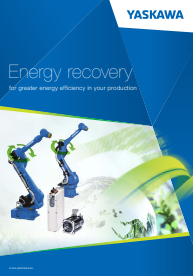More than 100 years committed to technical progress has made us the leading manufacturer in the fields of variable AC drives, servo drives, control technology and robotics.
Sustainability at Yaskawa
Shaping the future. Sustainably. Together.
Energy efficiency solutions such as the ones below, together with fostering environmental management by means of processes and green products, are an integral part of the Yaskawa global corporate strategy. By 2025, for example, we aim for our products to save 100 times as much in CO₂ emissions as our company produces.
In this respect, the Yaskawa Group is aligning its activities with the 17 Sustainable Development Goals of the UN and focusing on sustainable projects such as the digitalization of value chains, the use of automation to take over heavy and dirty tasks, and efficient food production in smart agriculture for a future that is sustainable, profitable, and worth living.
We want our technologies to contribute to the development of society by improving processes, advancing the performance and productivity of our industry, and thus creating a better quality of life. Of course, we also promote renewable energy for a healthy environment and a sustainably managed planet for us all.
Unrivaled solution: recovering braking energy
With MOTOMAN robots
We offer a technical solution for feeding robot and track/gantry/positioner braking energy back into the power supply system – as standard and without additional hardware. All larger MOTOMAN robots with payloads of 35 kg or more and the current YRC1000 robot controller are able to convert kinetic energy from downward and sideways motions directly into the power supply system. Depending on the motion profile, this considerably reduces the energy requirements of the robot.
This unrivaled technical solution is the result of Yaskawa’s decades of experience as a manufacturer of drive technology – all servo drives and
control packages are optimally adapted for use in our industrial robots.
The MOTOMAN robots tap further efficiency potential with their streamlined and compact design with low moved masses, and the rapid application of brakes during pauses in motion in order to switch off the active position control when not in use. Intelligent operation concepts of the user, including, for example, the automatic shutdown of the robots during planned breaks, also contribute to energy savings.
Energy savings at a glance:
- Due to streamlined design
- Due to efficient motors
- Due to energy saving functions such as “Servo off” as soon as the robot is at a standstill
- Due to efficient programming
- Due to energy recovery
With regenerative drives
Our regenerative solutions offer different functions so you will find the perfectly matching device for your application. The table shows you the key differences at a glance. With the buttons below, you can find all the details, manuals, CAD & CAE data and all the other downloads you need.
| U1000 | D1000 | R1000 | |
|---|---|---|---|
|
Power regeneration |
🗸 |
🗸 | 🗸 |
|
Motor drive |
🗸 | - | - |
|
Improve power factor |
🗸 | 🗸 | - |
|
Suppress input current harmonics |
🗸 | 🗸 | - |
| DC voltage boost | - | 🗸 | - |
| Multiple drives | - | 🗸 | - |
| 50 Hz bypass integrated circuit | 🗸 | - | - |
U1000
The U1000 is a highly efficient AC drive based on latest matrix converter technology. With full power regeneration capability, it offers great energy saving potential while reducing stress on grid components like transformers and power lines. It is the first choice for energy-efficient drive solutions with or without power regeneration.
D1000
The D1000 regenerative converter unit complements the Yaskawa product range with a low harmonics Active Frontend Solution. Suitable for both regenerative individual drives and systems of AC drives, servo axis or robots, the D1000 feeds excess braking energy back into the power grid instead of dissipating it as heat.
R1000
The R1000 regenerative braking unit is a smart and efficient alternative to dynamic braking for single or multi-axis drive installations with high amounts of regenerative motor operation. Instead of wasting it as heat, the R1000 feeds excessive braking energy back to the grid, thus reducing the energy consumption of the installation.






















